Fabrication in BBC Panorama 'Saving Syria’s Children'
Analysis of the 30 September 2013 BBC Panorama documentary 'Saving Syria's Children' and related BBC News reports, contending that sequences filmed by BBC personnel and others at Atareb Hospital, Aleppo on 26 August 2013 purporting to show the aftermath of an incendiary bomb attack on a nearby school are largely, if not entirely, staged.
About
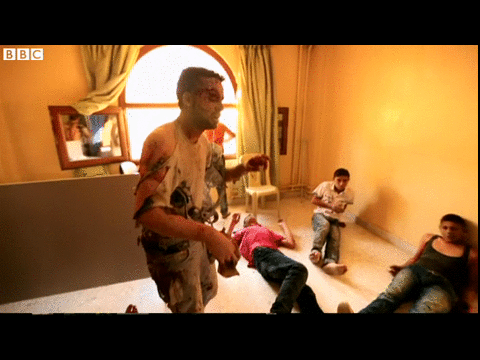 Syria crisis: Incendiary bomb victims ‘like the walking dead’ – Ten O’Clock News, BBC One, 29 August 2013 (03:02 – 03:19). Alleged casualties appear to begin writhing and moaning on cue of central figure. See Tableau of male alleged casualties.
Syria crisis: Incendiary bomb victims ‘like the walking dead’ – Ten O’Clock News, BBC One, 29 August 2013 (03:02 – 03:19). Alleged casualties appear to begin writhing and moaning on cue of central figure. See Tableau of male alleged casualties. 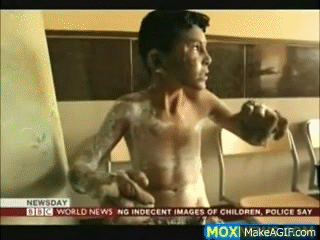
Alleged victim Ahmed Darwish appears to nod in response to instruction before turning to address the camera.
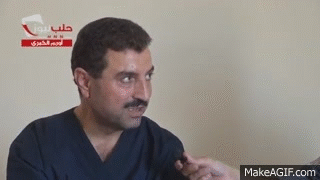 Medic featured in BBC’s reports appears to demonstrate amusement in interview filmed the next day – see Laughing medic and The Napalm d’Or?.
Medic featured in BBC’s reports appears to demonstrate amusement in interview filmed the next day – see Laughing medic and The Napalm d’Or?.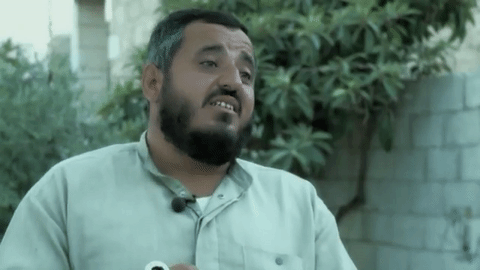 Alleged eye witness Abu Youssef, interviewed in a video uploaded to You Tube less than a week after the alleged attack. Youssef’s words at this point have been translated as “The first bomb hit a residential area, the second one a student centre”. (See also Conflicting accounts of time of “napalm bomb” and The Napalm d’Or?).
Alleged eye witness Abu Youssef, interviewed in a video uploaded to You Tube less than a week after the alleged attack. Youssef’s words at this point have been translated as “The first bomb hit a residential area, the second one a student centre”. (See also Conflicting accounts of time of “napalm bomb” and The Napalm d’Or?).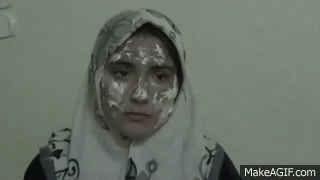 Alleged napalm victim appears entirely unscathed – see Woman in black dress (end of article).
Alleged napalm victim appears entirely unscathed – see Woman in black dress (end of article).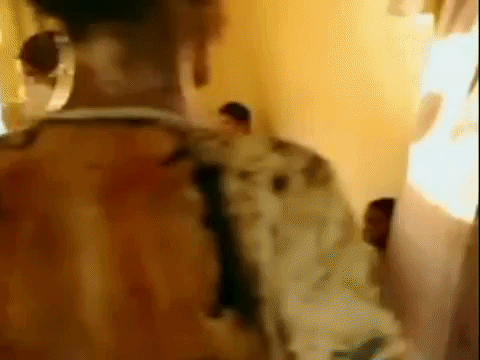 Alleged napalm victim (white t-shirt) appears to sway and lurch in bizarre manner in ‘Saving Syria’s Children’ – see Alleged teacher and The Napalm d’Or?.
Alleged napalm victim (white t-shirt) appears to sway and lurch in bizarre manner in ‘Saving Syria’s Children’ – see Alleged teacher and The Napalm d’Or?.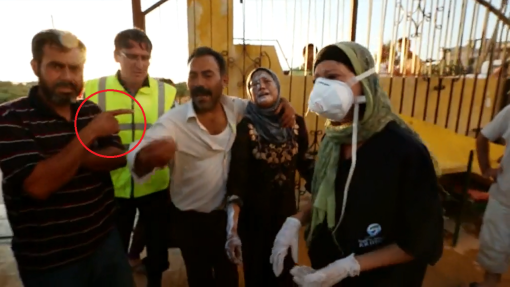 Unidentified male appears to be alerting BBC cameraman Darren Conway to an emotive scene – see Saving Syria’s Children: The Director’s Cut?.
Unidentified male appears to be alerting BBC cameraman Darren Conway to an emotive scene – see Saving Syria’s Children: The Director’s Cut?.
Presentation: Media on Trial, 19 October 2017, Bloomsbury Central Baptist Church, London. Please note that this video has been age restricted by YouTube on the grounds that “it may not be appropriate for a general audience” – an alternate copy can be viewed here.
Insight: Saving Syria’s Children – The Worst Case Of Fake News?, 15 February 2017
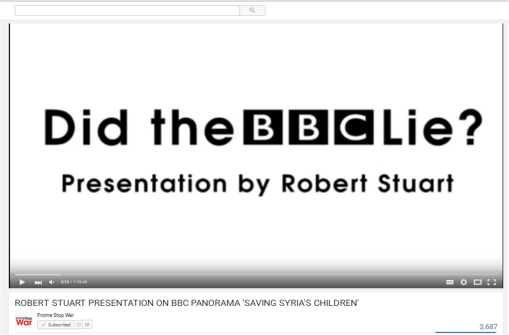 Presentation for Frome Stop War, 1 March 2016.
Presentation for Frome Stop War, 1 March 2016.
Listed below are the original BBC reports referenced in this blog, including an HQ copy of Saving Syria’s Children(relevant section commences 30:38), plus independent reports and commentary.
Introduction
Date and time of the alleged incident
Panorama team embedded with Islamic State partner group
Panorama team films ISIS vehicle and its occupants
BBC falsely claimed victim “died on his way to hospital in Turkey”
The Demotix photographs
Conflicting accounts of first victim and other discrepancies in accounts by Dr Saleyha Ahsan, Dr Rola Hallam and Ian Pannell
Grinning victim
Alleged injuries of baby and his father
Plausibility of injuries and demeanour of alleged victims
HOSPEX injury simulation techniques
Unidentified western male filmed at Atareb hospital
Second unidentified European at Atareb Hospital
Woman in black dress
Munitions allegedly used in the attack
FSA commander attests attack did not take place
Identification of participant in hospital footage
Dr Rola Hallam and Hand in Hand for Syria
Atareb: “a basic hospital funded by handouts”
Regular Atareb Hospital staff absent on day of alleged attack
Violations Documentation Center in Syria
Videos on the ‘Free Halab’ blog
Misleading and manipulative editing
Victim who “fought to be allowed into hospital” had already been treated
Laughing medic
Senior White Helmets present at Atareb Hospital on 26 August 2013
Mughira Al Sharif
BBC Worldwide blocks You Tube copies of ‘Saving Syria’s Children’
Former UK ambassador: BBC “exaggerated” and reshot scenes
Substitution of footage – BBC Newsnight 29 August 2014
Apparent breaches of Geneva Convention by Dr Saleyha Ahsan
Date and time of the alleged incident
Panorama team embedded with Islamic State partner group
Panorama team films ISIS vehicle and its occupants
BBC falsely claimed victim “died on his way to hospital in Turkey”
The Demotix photographs
Conflicting accounts of first victim and other discrepancies in accounts by Dr Saleyha Ahsan, Dr Rola Hallam and Ian Pannell
Grinning victim
Alleged injuries of baby and his father
Plausibility of injuries and demeanour of alleged victims
HOSPEX injury simulation techniques
Unidentified western male filmed at Atareb hospital
Second unidentified European at Atareb Hospital
Woman in black dress
Munitions allegedly used in the attack
FSA commander attests attack did not take place
Identification of participant in hospital footage
Dr Rola Hallam and Hand in Hand for Syria
Atareb: “a basic hospital funded by handouts”
Regular Atareb Hospital staff absent on day of alleged attack
Violations Documentation Center in Syria
Videos on the ‘Free Halab’ blog
Misleading and manipulative editing
Victim who “fought to be allowed into hospital” had already been treated
Laughing medic
Senior White Helmets present at Atareb Hospital on 26 August 2013
Mughira Al Sharif
BBC Worldwide blocks You Tube copies of ‘Saving Syria’s Children’
Former UK ambassador: BBC “exaggerated” and reshot scenes
Substitution of footage – BBC Newsnight 29 August 2014
Apparent breaches of Geneva Convention by Dr Saleyha Ahsan
Original BBC reports
Complaints correspondence with BBC
BBC Reports on Aftermath of Syrian School Attack Were Largely Staged – Radio Sputnik interview
Did The BBC Lie?
Letter to Jeremy Corbyn MP
Freedom of Information request
Bias and lack of analysis in ‘Saving Syria’s Children’
Other reports and commentary
Notes
Complaints correspondence with BBC
BBC Reports on Aftermath of Syrian School Attack Were Largely Staged – Radio Sputnik interview
Did The BBC Lie?
Letter to Jeremy Corbyn MP
Freedom of Information request
Bias and lack of analysis in ‘Saving Syria’s Children’
Other reports and commentary
Notes
Introduction
On 29 August 2013, as the UK House of Commons vote on possible military intervention in Syria was underway [1], BBC News at Ten broadcast a report by Ian Pannell and cameraman Darren Conway which claimed that a Syrian fighter jet had dropped an incendiary bomb containing a “napalm-type” substance – possibly thermite – on the playground of an Aleppo school.
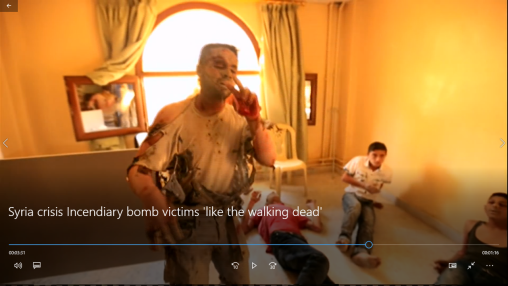
Click on image for copy of BBC News report of 29 August 2013. Previously available on YouTube, removed January 2019. The report remains on the BBC News website.
The report contained harrowing scenes of teenage boys and young men, their skin apparently in tatters, racing into what the report describes as “a basic hospital funded by handouts” to be treated for burns. In one particularly disturbing scene (from 03:02 – 03:19) a tableau of young men writhe, drool and groan, seemingly in great distress.
On further viewings, however, this scene in particular is strikingly odd. The young men are initially quiet and static. The central figure (Mohammed Asi) looks directly into the camera for several moments before raising his arm, at which point the group instantly becomes animated and starts moaning in unison.
Asi begins to stagger and lurch; the boy in the black vest suddenly pitches onto his side, briefly looking up again in the same direction as the others before ultimately slumping onto his front; the boy in red (Anas Said Ali) raises his head and peers quizzically around, while the boy in the white shirt rises effortlessly to his feet before pulling up a chair. [2] As the camera pulls back a boy in a yellow ‘Super-9’ t-shirt (Lutfi Arsi) rises from an odd sprawling position, flailing his head and torso and rolling his eyes as a team of medics sweeps in. The medic to the right of screen immediately begins attending to Said Ali’s foot, without examining it. Some images from the sequence are reproduced below. [3]
Compare the demeanour of the young men above with that of Vietnam napalm bombing survivor Kim Phuc and these Egyptian victims of an Israeli napalm attack.
This scene and other questionable aspects of this brief report prompted my first letter to the BBC on 4 October 2013.
While I was completing this letter, on 30 September 2013, the BBC broadcast a follow-up news report shortly prior to the transmission of the Panorama special Saving Syria’s Children the same evening:
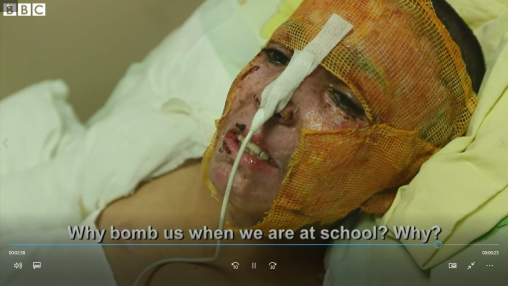
Click on image for copy of BBC News report of 30 September 2013. The report remains on the BBC News website.
Comparing the 29 August and 30 September reports a discrepancy in the soundtrack was apparent. In the first, Dr Rola Hallam (her face covered by a mask) had referred to “napalm”, in the second she said “chemical weapon”. I commented on this in the PS to my letter. The audio editing was subsequently discussed by former UK ambassador and blogger Craig Murray here and here. [4] Speculation on this point has since been widespread (see for example here and here; my opinion on the matter is here). My concern remains on the evidence of wider fabrication in the hospital scenes.
The BBC’s initial response of 2 December 2013 dealt largely with the editing of Dr Rola Hallam’s words. My correspondence with the BBC continued. Some of the main points which arose, or have arisen subsequently, are as follows.
Date and time of the alleged incident
Fuller details here. See also this article on the website OffGuardian and Outbreak of journalism at the Frontline Club?
According to the BBC’s reports the alleged attack took place on Monday 26 August 2013. [5]
Accounts of the time of the alleged bombing span a range of six hours. A Human Rights Watch report states (p12) that the attack occurred “around midday”; the HRW report links to a further report by the Violations Documentation Center in Syria – a regularly cited BBC source -which claims (p4) the attack took place at 2.00pm and directly quotes activist Mustapha Haid as saying he first heard rumours of a “chemical attack” at “3 in the afternoon”. Haid then “immediately” went to Atareb Hospital to film the alleged victims.
‘Saving Syria’s Children’ reporter Ian Pannell categorically stated in BBC Complaints correspondence that the attack happened “at around 5.30pm at the end of the school day”. When questioned about the time of the incident, Pannell’s sole BBC colleague on the programme, cameraman, director and producer Darren Conway, responded “I would say it was around, I don’t know, between three and five, something like that”. It is unclear whether Conway was giving his assessment of when the alleged incendiary attack on the school in Urm al-Kubra (Urem Al-Kubra) took place or was referring to the subsequent arrival of alleged victims at Atareb Hospital several miles away, where he filmed them. Video of Conway’s interview at The Frontline Club, London, in which this apparent contradiction arose remains unpublished. The Frontline’s justification for this change in its usual policy appears unpersuasive.
Another alleged eyewitness claims the attack occurred sometime between 5.30pm and 6.00pm. A contemporary Turkish article(translated here) quotes a Syrian doctor “who came to Turkey together with the wounded” as stating:
“At 6 pm yesterday evening, warplanes fired a missile and then sprayed a phosphorus bomb.”
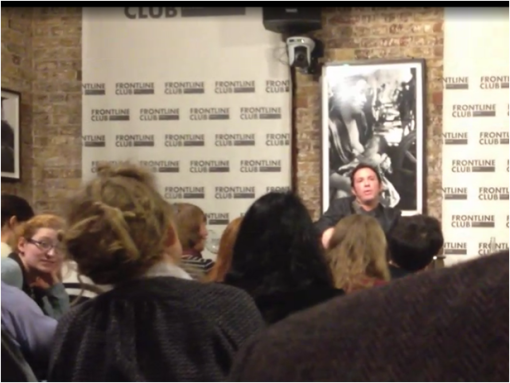
‘Saving Syria’s Children’ cameraman, director and producer Darren Conway at the Frontline Club, London on 15 October 2014, responding to a question about the time of the alleged incendiary bomb attack: “Towards the end of the day, yeah, I mean I don’t remember the exact time… …I would say it was around, I don’t know, between three and five, something like that.” (Mobile phone footage http://1drv.ms/1DfBr2T). Conway’s sole BBC colleague on “Saving Syria’s Children”, reporter Ian Pannell, has stated that the alleged attack on the school in Urm Al-Kubra, some distance from Atareb Hospital where Conway filmed the alleged victims, occurred “at around 5.30pm at the end of the school day”.
Panorama team embedded with Islamic State partner group
Fuller details here.
Scrutiny of scenes in Saving Syria’s Children reveal that reporter Ian Pannell and cameraman Darren Conway were embedded with jihadi group Ahrar al-Sham which, according to Human Rights Watch, had three weeks earlier worked alongside Islamic State (IS) and al-Qaeda affiliate Jabhat al-Nusra as one of “the key fundraisers, organizers, planners, and executors” of an attack in which at least 190 civilians were killed.
A 2013 Foundation for Defense of Democracies report states that a “leading figure” in Ahrar al-Sham, Abu Khalid al-Suri – real name Mohamed Bahaiah – had been identified by Spanish investigators as “one of Osama bin Laden’s most trusted couriers”.
Update October 2017: Shadow Foreign Secretary Emily Thornberry MP has written to BBC Panorama editor Rachel Jupp relaying my concerns about this aspect of Saving Syria’s Children.

Pickup truck in convoy transporting BBC reporter Ian Pannell and cameraman Darren Conway on 26 August 2013 bears the former logo of Salafist militant group Ahrar al-Sham (Saving Syria’s Children, BBC1, broadcast 30 September 2013).
Panorama team films ISIS vehicle and its occupants
Scenes filmed by BBC cameraman Darren Conway for Saving Syria’s Children feature an ambulance displaying the ISIS flag.
The proximity of Conway and Panorama reporter Ian Pannell to the ISIS vehicle and its armed occupants at Atareb Hospital on 26 August 2013 contrasts markedly with an ostensibly tense scene shot the previous day in which the two-man BBC team passes through an ISIS checkpoint in apparent fear for their lives.
BBC falsely claimed victim “died on his way to hospital in Turkey”
Fuller details here. See also section below Violations Documentation Center in Syria.
In complaints correspondence the BBC claimed that alleged teenage victim Lutfi Arsi “died on his way to hospital in Turkey”. However, in a gallery of images accompanying a contemporary report on the website of Turkish daily newspaper Hürriyet, Arsi is pictured arriving in an ambulance at Reyhanli State Hospital, Turkey.
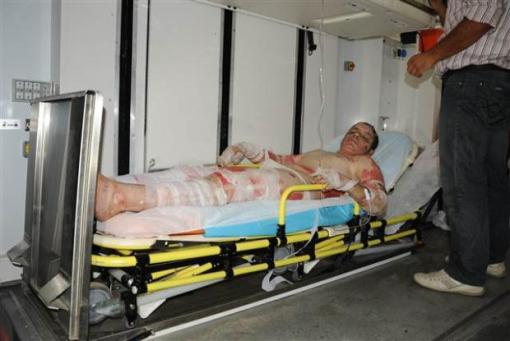
Alleged incendiary bomb victim Lutfi Arsi arriving at Reyhanli State Hospital, Turkey on the evening of Monday 26th August 2013. The BBC has stated that Arsi “died on his way to hospital in Turkey”.
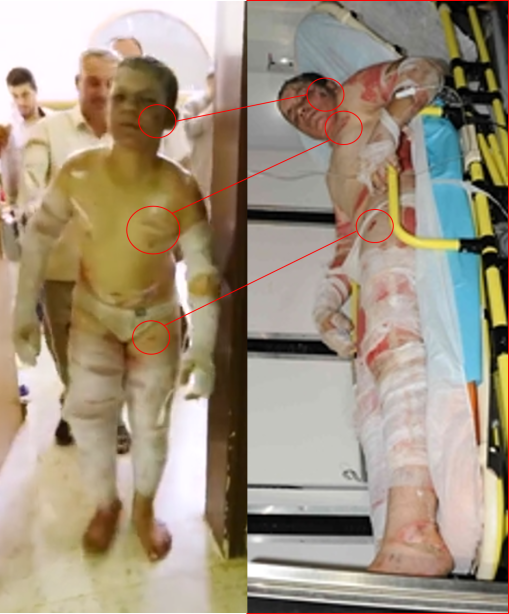
Lutfi Arsi at 37:52 in Saving Syria’s Children (left) and arriving at Reyhanli State Hospital, Turkey later the same day. A comparison of the pattern of alleged injuries makes it clear that it is the same boy in each image.
The Demotix photographs
Fuller details here.
A series of eighteen photographs showing two alleged victims originally appeared on the photo journalism website Demotix dated 25 August 2013. Demotix later amended the date of the photographs to 26 August. When the images were dated 25 August, Ian Pannell denied that they featured victims from his report [6]; after the date had been changed, the BBC acknowledged that they did.
Further Reading: https://bbcpanoramasavingsyriaschildren.wordpress.com/#medic



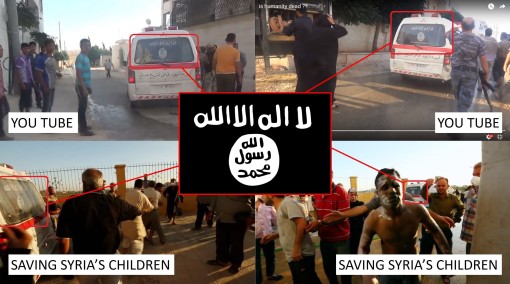



Geen opmerkingen:
Een reactie posten